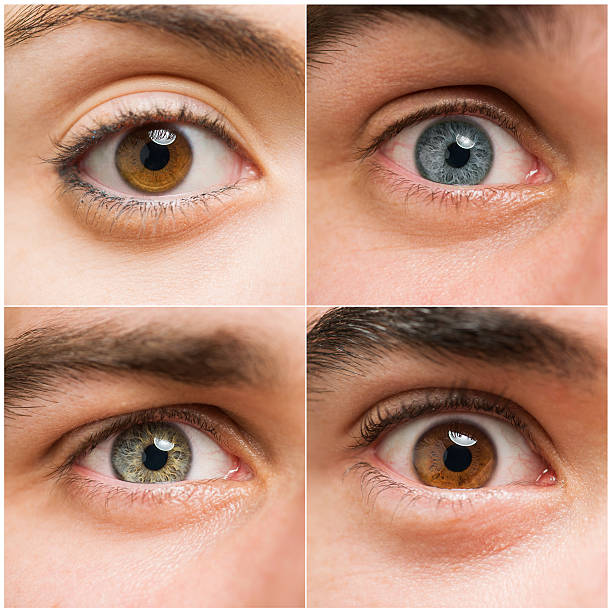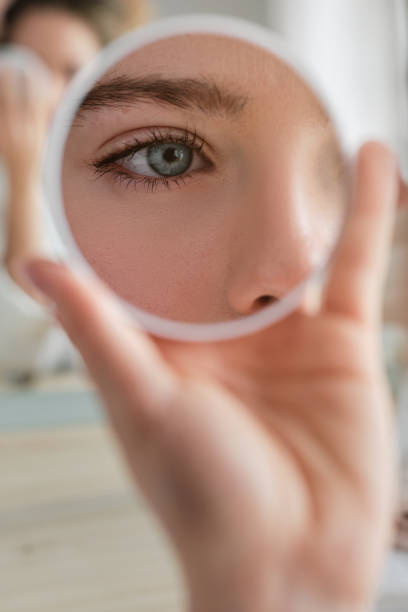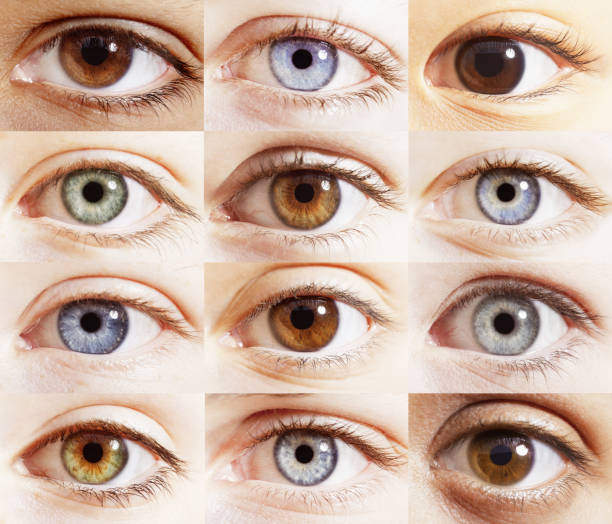Din vagn är tom
Unraveling the Mysteries: The Most Common Eye Colors Worldwide

Eyes are not just windows to the soul; they are also a fascinating aspect of human diversity. This article delves into the most common eye colors around the world, exploring their origins, significance, and the art inspired by them.
Introduction to Eye Colors
Eye color is determined by the amount and type of pigments in the iris. The primary pigment responsible for eye color is melanin, which also determines skin and hair color. The genetic basis of eye color is complex, involving multiple genes that interact in various ways to produce the wide range of eye colors seen in humans.
The iris, the colored part of the eye, contains two layers: the front layer (stroma) and the back layer (epithelium). The distribution and concentration of melanin in these layers determine whether an individual's eyes are brown, blue, green, hazel, or gray. Understanding the science behind eye color not only satisfies our curiosity but also sheds light on human genetics and evolution.
Eye color is a captivating subject that has inspired countless works of art and photography. From the mesmerizing gaze captured in eye photography to the intricate details showcased in iris art, the beauty and diversity of eye colors continue to captivate artists and viewers alike.
Brown Eyes: The Most Common
Brown eyes are the most prevalent eye color globally. They are dominant due to the high concentration of melanin in the iris. This pigment absorbs more light, giving the eyes a darker appearance. Brown eyes are especially common in Africa, Asia, and the Middle East.
Distribution Across Populations
In Africa, nearly 100% of the population has brown eyes. This high prevalence is due to the evolutionary advantage of having more melanin, which protects against the sun's harmful ultraviolet rays. Similarly, in Asia, brown eyes dominate, with a significant majority of people possessing this eye color.
Cultural Significance
Brown eyes have been celebrated in various cultures for their depth and warmth. In many societies, brown eyes are associated with strength, reliability, and wisdom. These cultural perceptions have influenced art and literature, where brown-eyed characters often embody these traits.
Brown eyes have also been a popular subject in eye portrait photography, capturing the soulful and expressive nature of this eye color. The rich hues and intricate patterns found in brown eyes provide endless opportunities for artistic exploration and interpretation.
Blue Eyes: A Genetic Mutation
Blue eyes are less common and are the result of a genetic mutation that occurred around 6,000 to 10,000 years ago. This mutation affects the OCA2 gene, which reduces the production of melanin in the iris, resulting in blue eyes.
Origins and Geographical Distribution
The mutation that causes blue eyes is believed to have originated in the Black Sea region. Today, blue eyes are most commonly found in people of European descent, particularly in countries like Estonia, Finland, and Sweden, where over 80% of the population has blue eyes.
Blue Eyes in Art and Culture
Blue eyes have often been idealized in Western art and culture. They are frequently depicted in portraits and paintings, symbolizing purity, innocence, and beauty. In modern times, blue eyes continue to be a popular subject in eye photography, capturing the imagination of artists and photographers alike.
The striking contrast between blue eyes and other facial features has made them a sought-after subject in various forms of eye art. From realistic renderings to abstract interpretations, blue eyes have inspired countless artistic creations that celebrate their unique allure.
Green Eyes: The Rarest of Them All
Green eyes are the rarest eye color, found in only about 2% of the world's population. The green hue is the result of a moderate amount of melanin and the presence of a yellowish pigment called lipochrome.
Genetic Factors
The genetic basis of green eyes is not entirely understood, but it is believed to involve multiple genes. The interplay of these genes results in the unique green color, which can vary in shade from person to person.
Occurrence in Various Regions
Green eyes are most commonly found in people of Celtic and Germanic ancestry. Countries like Ireland and Scotland have a higher percentage of green-eyed individuals. Despite their rarity, green eyes have a significant cultural impact, often being associated with mysticism and allure.
The enigmatic nature of green eyes has made them a popular subject in various forms of eyeball art. Artists and photographers alike are drawn to the captivating and mysterious qualities of green eyes, using them as a focal point in their creative works.
Hazel Eyes: A Beautiful Blend
Hazel eyes are a mix of brown and green, creating a unique and variable eye color. The appearance of hazel eyes can change depending on lighting conditions, making them particularly captivating.
Characteristics of Hazel Eyes
Hazel eyes often contain a combination of colors, including brown, green, and gold. This blend results from the varying distribution of melanin and the presence of lipochrome. The dynamic nature of hazel eyes makes them a popular subject in eye art and iris art.
Distribution and Cultural Perception
Hazel eyes are most commonly found in people of European descent. They are often perceived as exotic and intriguing, with many cultures attributing special significance to this eye color. In literature and film, characters with hazel eyes are frequently portrayed as mysterious and charismatic.
The versatility of hazel eyes allows for endless artistic interpretations. From capturing the subtle shifts in color to highlighting the intricate patterns within the iris, hazel eyes provide a rich canvas for artists and photographers to explore and showcase their creativity.
Gray Eyes: A Unique Hue
Gray eyes are a rare and unique eye color, characterized by a low amount of melanin and a high concentration of collagen in the stroma. This combination scatters light, giving the eyes a gray appearance.
Science Behind Gray Eyes
The exact mechanism behind gray eyes is not fully understood, but it is believed to involve the scattering of light by the iris's collagen fibers. This scattering effect creates the distinctive gray color, which can sometimes appear blue or green under different lighting conditions.
Prevalence and Cultural Impact
Gray eyes are most commonly found in people of Eastern European descent. They are often associated with wisdom and intelligence, and their rarity makes them a sought-after feature in eye portrait photography and eyeball art.
The ethereal quality of gray eyes has inspired artists and photographers to capture their beauty in various mediums. From black and white photography that emphasizes the depth and intensity of gray eyes to colorful illustrations that highlight their unique hue, gray eyes continue to captivate and inspire creative minds.
The Role of Melanin in Eye Color
Melanin plays a crucial role in determining eye color. The amount and type of melanin in the iris affect how light is absorbed and reflected, resulting in different eye colors.
Varying Levels of Melanin
-
High Melanin Levels: Result in brown eyes, as more light is absorbed.
-
Moderate Melanin Levels: Lead to hazel or green eyes, with a mix of light absorption and reflection.
-
Low Melanin Levels: Produce blue or gray eyes, as less light is absorbed and more is scattered.
Genetic Influence
The genes responsible for melanin production and distribution are inherited from both parents. This genetic inheritance explains the diversity of eye colors within families and across populations.
Understanding the role of melanin in eye color not only enhances our appreciation for the complexity of human genetics but also provides insights into the artistic possibilities of capturing and interpreting eye colors in various forms of eye art and eye photography.
Eye Color and Health
Eye color can sometimes be linked to certain health conditions. While the connections are not always direct, research has shown some interesting correlations.
Light Sensitivity
People with lighter eye colors, such as blue or gray, tend to be more sensitive to bright light. This sensitivity is due to the lower amount of melanin, which provides less protection against the sun's rays.
Risk of Eye Diseases
Studies have suggested that individuals with lighter eye colors may be at a higher risk for certain eye conditions, such as macular degeneration. Conversely, those with darker eyes may have a higher risk of developing cataracts.
Psychological Impact
Eye color can also influence perceptions and social interactions. For example, people with blue eyes are often perceived as more trustworthy, while those with brown eyes are seen as more dominant. These perceptions can affect self-esteem and social dynamics.
Exploring the connections between eye color and health not only deepens our understanding of human biology but also highlights the importance of eye care and protection. Artists and photographers can use this knowledge to create works that raise awareness about eye health and celebrate the beauty of healthy eyes.
Eye Color in Art and Photography
Eye colors have inspired countless works of art and photography. Artists and photographers often use eye color to convey emotion, character, and beauty.
Notable Examples
-
Vincent van Gogh: His portraits often highlight the subject's eye color, adding depth and personality to the painting.
-
Steve McCurry's "Afghan Girl": The striking green eyes of the girl in this iconic photograph have captivated viewers worldwide.
Significance in Visual Arts
Eye color is a powerful tool in visual arts, allowing artists to create a connection with the viewer. The use of eye color in eye photography and eye art continues to evolve, pushing the boundaries of creativity and expression.
From hyper-realistic paintings that capture every nuance of the iris to abstract interpretations that use eye color as a symbolic element, the possibilities for artistic exploration are endless. Eye color has the power to evoke emotions, tell stories, and create a lasting impact on the viewer.
Final Thoughts
The diversity of eye colors is a testament to the complexity and beauty of human genetics. From the common brown eyes to the rare green and gray hues, each eye color tells a unique story of evolution, culture, and individuality.
Understanding the science behind eye color not only satisfies our curiosity but also provides insights into human health and genetics. The cultural significance of eye color adds another layer of richness, influencing art, literature, and social perceptions.
In the end, our eyes are more than just a physical feature. They are a reflection of our heritage, our health, and our humanity. Whether captured in a stunning photograph or celebrated in a piece of eye art, the beauty of our eyes continues to inspire and fascinate.
As artists and photographers continue to explore the depths of eye color, we are reminded of the incredible diversity and beauty that exists within the human race. Through their creative works, they invite us to look beyond the surface and appreciate the unique stories and experiences that lie behind each pair of eyes.




